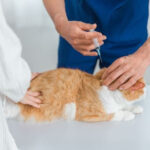Many people believe petting a cat is as simple as stroking them from head to tail. However, just like humans, cats have unique personalities and preferences, especially when it comes to touch. Understanding your cat’s individual “touch threshold” is key to building a loving and trusting relationship. If your cat runs away or even scratches when you try to pet them, it’s not because they don’t love you; it’s likely they’re telling you they prefer a different approach to affection.
Understanding Cat Touch Preferences
Every cat is an individual, and their preferences for petting vary widely. Some cats adore head pats, while others dislike them intensely. Similarly, some cats enjoy scratches near their tail, while others find it irritating. Even the pressure of touch matters – some prefer a firm hand, while others prefer a gentle caress.
This variation in touch preference, or “touch threshold,” is evident even in very young kittens. This highlights the importance of learning your cat’s specific likes and dislikes, particularly if you’ve adopted an adult cat who has already developed a lifetime of touch preferences.
Reading Cat Body Language: Listen to What They’re Saying
Cats are small creatures in a large world, and approaching them from above can feel intimidating, like a predator looming. Cats with negative past experiences may perceive hands as especially threatening. Therefore, it’s crucial to respect their boundaries and pay attention to their body language to ensure they feel safe and comfortable during petting.
If a cat freezes, flattens their ears, or tightly closes their eyes while you are petting them, these are clear signals that they are uncomfortable and your petting technique needs adjustment. These are your cat’s way of saying “please stop” or “not like that.”
The Right Way to Approach and Pet: Let the Cat Lead
To make petting a positive experience for your cat, start by getting down to their level. This makes you appear less imposing and more approachable. Allow the cat to come to you and rub against your legs or arms if you are sitting. In feline communication, this rubbing behavior signifies trust and indicates they consider you a friendly companion.
The most effective way to initiate petting with a new cat is to “ask” if they want to be petted. As cat behaviorist Jackson Galaxy advises, “Let the cat pet you!” Offer a finger or knuckle at their eye level and observe their reaction.
A cat receptive to petting will move towards your hand, even if it’s just a slight lean. Their eyes will appear soft and relaxed, with pupils of normal size (unless the lighting is dim). A slow blink is a significant sign of trust and comfort. Their ears and whiskers will be forward and relaxed. If they initiate contact by touching you, it’s their way of giving you permission to proceed.
Where to Pet Your Cat: Finding the Sweet Spots
While some cats enjoy head pats, many prefer being petted starting from their shoulders. Begin with a very gentle touch. If your cat seems particularly sensitive to hands, try petting them with the back of your hand, which can feel less threatening.
A strong indicator that a cat is enjoying the petting is when they push back slightly into your hand. When you reach the base of their tail and they elevate it into an “elevator tail” position, you’ve definitely discovered a spot they love! This upward tail posture is a sign of contentment and pleasure.
Recognizing Overstimulation: Knowing When to Stop
Cats can become overstimulated, especially when they are still getting to know you. It’s crucial to recognize the signs of overstimulation and stop petting before your cat becomes agitated. Be alert for these behaviors that indicate your cat has had enough:
- Restlessness or fidgeting
- Skin rippling or twitching
- Ears flattening or flicking back and forth
- Tail thumping or thrashing
- Turning their head towards your hand in a warning
If you observe any of these signs, immediately stop petting. Wait for the cat to initiate contact again. If they don’t, wait until another time for a petting session.
If a cat becomes overstimulated to the point of nipping, completely withdraw your attention by either walking away or gently placing the cat off your lap. Consistent responses to nipping from everyone in the household can discourage this behavior over time. Never continue petting a cat once they are in “nip mode,” as this can inadvertently reinforce the nipping behavior.
Picking Up Your Cat: Building Trust First
Many cats dislike being picked up, especially if trust hasn’t been fully established. Imagine being a small, ten-pound creature suddenly lifted high into the air by a being many times your size. It’s understandable why they might feel insecure and struggle!
If you want to pick up your cat, begin by acclimating them to being on your lap. Using food treats can be helpful in creating a positive association. Gradually progress to lifting them from your lap to your shoulders, supporting their back legs with one arm and their front with the other.
Observe your cat for signs of comfort, such as a relaxed body, soft eyes, and leaning into you. Building this trust is essential before attempting to stand up while holding them, gradually increasing the height and reinforcing their understanding that they are safe with you.
Purring and kneading (making biscuits) while being petted are the highest compliments a cat can give. These behaviors, combined with rubbing and pushing into your hand, signify deep contentment and affection in cat language. By paying attention to your cat’s cues and respecting their preferences, you can develop a petting style that both you and your feline friend will enjoy, strengthening your bond and creating a harmonious relationship.

